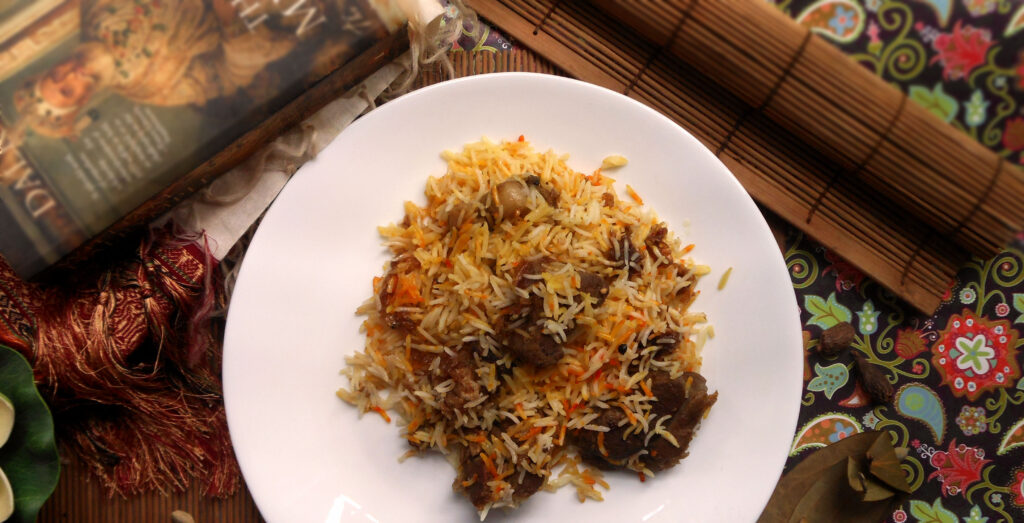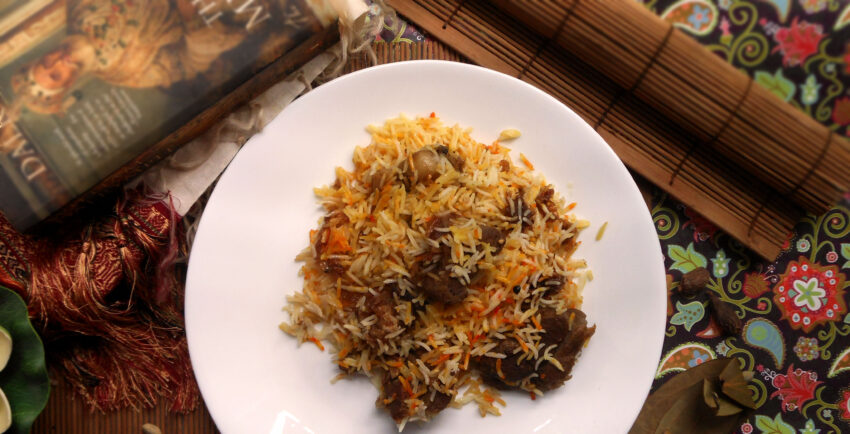
Essay About Biryani: A Comprehensive Guide to History, Types, and Cultural Significance
Biryani, a dish synonymous with celebration, flavor, and cultural heritage, holds a special place in the culinary world. This essay delves into the multifaceted aspects of biryani, exploring its rich history, diverse regional variations, preparation techniques, and its enduring cultural significance. We aim to provide a comprehensive understanding of this beloved dish, going beyond mere recipes to uncover its deeper layers of meaning and importance. Whether you’re a seasoned biryani connoisseur or a curious newcomer, this exploration will offer a richer appreciation for the art and science of biryani making.
The Historical Tapestry of Biryani
The origins of biryani are shrouded in a delightful mix of legend and historical fact. While pinpointing the exact genesis remains elusive, most accounts trace its roots to Persia and Central Asia. One popular theory suggests that biryani evolved from pilaf dishes brought to India by the Mughals. These early forms of biryani were likely simpler, featuring rice, meat, and aromatic spices. Over time, the dish evolved, incorporating local ingredients and culinary techniques, resulting in the diverse range of biryanis we know today.
Mughal Influence on Biryani’s Evolution
The Mughal emperors played a pivotal role in popularizing and refining biryani in India. Royal kitchens became breeding grounds for culinary innovation, with chefs experimenting with new ingredients and techniques. During the Mughal era, biryani transitioned from a simple dish to a sophisticated culinary masterpiece, often featuring elaborate layering, slow cooking, and the use of premium ingredients like saffron, dried fruits, and nuts.
The Deccan Connection: A Unique Biryani Style
The Deccan region, particularly Hyderabad, developed its own distinctive biryani style, characterized by the use of long-grain basmati rice, marinated meat, and a unique cooking method called *dum pukht*. This technique involves slow-cooking the biryani in a sealed pot, allowing the flavors to meld and infuse the rice and meat with aromatic goodness. Hyderabadi biryani is renowned for its rich, flavorful, and slightly spicy profile.
A Kaleidoscope of Biryani Varieties
One of the most fascinating aspects of biryani is its incredible diversity. From the spicy flavors of Andhra biryani to the subtle aromas of Lucknowi biryani, each region in India has its own unique take on this iconic dish. This section explores some of the most popular and distinctive biryani varieties.
Hyderabadi Biryani: The Jewel of the Deccan
Hyderabadi biryani is arguably the most famous and widely recognized biryani variety. It is characterized by the *dum pukht* cooking method, the use of long-grain basmati rice, and a rich blend of spices. The meat, typically chicken or mutton, is marinated in yogurt, ginger-garlic paste, and a medley of aromatic spices before being layered with rice and slow-cooked in a sealed pot. Hyderabadi biryani is known for its intense flavor and tender, succulent meat.
Lucknowi (Awadhi) Biryani: A Symphony of Subtle Flavors
Lucknowi biryani, also known as Awadhi biryani, is a more delicate and subtly flavored variety. It is characterized by the use of aromatic spices like saffron, rose water, and kewra water, which impart a fragrant and floral aroma to the dish. The meat is typically cooked separately from the rice and then layered together before being slow-cooked in a sealed pot. Lucknowi biryani is known for its refined flavor and tender, melt-in-your-mouth texture.
Calcutta Biryani: A Touch of Sweetness
Calcutta biryani is a unique variety that incorporates potatoes and eggs, adding a touch of sweetness and creaminess to the dish. The rice is typically flavored with saffron and rose water, and the meat is cooked separately before being layered with rice, potatoes, and eggs. Calcutta biryani is known for its mild flavor and comforting texture.
Malabar Biryani: A Coastal Delight
Malabar biryani, from the coastal region of Kerala, features a blend of South Indian and Middle Eastern flavors. It often incorporates local spices like cardamom, cloves, and cinnamon, as well as coconut milk, which adds a rich and creamy texture to the dish. The meat is typically cooked with the rice, resulting in a flavorful and aromatic biryani.
The Art and Science of Biryani Making
Making biryani is both an art and a science. It requires a deep understanding of ingredients, techniques, and the delicate balance of flavors. This section explores some of the key elements involved in creating a perfect biryani.
Choosing the Right Rice: The Foundation of Biryani
The type of rice used is crucial to the success of a biryani. Long-grain basmati rice is generally considered the best choice, as it is known for its delicate aroma, fluffy texture, and ability to absorb flavors without becoming mushy. Before cooking, the rice should be soaked for at least 30 minutes to remove excess starch and ensure even cooking.
The Spice Symphony: Creating the Perfect Flavor Profile
Spices are the heart and soul of biryani. The specific blend of spices varies depending on the region and the type of biryani being made, but common ingredients include cardamom, cloves, cinnamon, cumin, coriander, turmeric, and chili powder. The spices should be freshly ground to maximize their aroma and flavor. The key is to create a harmonious balance of flavors, avoiding any single spice from overpowering the others.
The Dum Pukht Technique: Slow Cooking for Maximum Flavor
The *dum pukht* technique, which involves slow-cooking the biryani in a sealed pot, is essential for achieving the perfect flavor and texture. This method allows the flavors to meld and infuse the rice and meat with aromatic goodness. The pot is typically sealed with dough or a damp cloth to prevent steam from escaping. The biryani is then cooked over low heat for several hours, allowing the ingredients to slowly simmer and develop their full flavor potential.
Biryani’s Enduring Cultural Significance
Biryani is more than just a dish; it is a symbol of celebration, hospitality, and cultural identity. It is often served at weddings, festivals, and other special occasions, and it is a staple of Indian cuisine around the world. This section explores the cultural significance of biryani and its role in shaping culinary traditions.
Biryani as a Symbol of Celebration
Biryani is often associated with joyous occasions and celebrations. Its rich flavor, aromatic spices, and festive presentation make it a perfect dish for sharing with family and friends. Serving biryani at a gathering is a sign of generosity and hospitality, and it is a way to create a memorable and enjoyable experience for all.
Biryani’s Role in Shaping Culinary Traditions
Biryani has had a profound impact on Indian cuisine and has inspired countless variations and adaptations. It has also influenced culinary traditions in other parts of the world, particularly in Southeast Asia and the Middle East. The popularity of biryani has helped to promote Indian cuisine globally and has contributed to the rich and diverse culinary landscape we enjoy today.
The Future of Biryani: Innovation and Adaptation
While rooted in tradition, biryani continues to evolve and adapt to modern tastes and preferences. Chefs are experimenting with new ingredients, techniques, and flavor combinations, creating innovative and exciting new biryani varieties. This section explores some of the trends shaping the future of biryani.
Vegetarian and Vegan Biryani: Catering to Diverse Dietary Needs
With the growing popularity of vegetarian and vegan diets, there is an increasing demand for vegetarian and vegan biryani options. Chefs are responding to this demand by creating biryanis that feature a wide range of vegetables, legumes, and plant-based proteins. These vegetarian and vegan biryanis are often just as flavorful and satisfying as their meat-based counterparts.
Fusion Biryani: Blending Culinary Traditions
Fusion biryani is another exciting trend that involves blending culinary traditions from different parts of the world. Chefs are experimenting with new spices, ingredients, and techniques to create unique and innovative biryani varieties that reflect a global palate. These fusion biryanis offer a fresh and exciting twist on a classic dish.
Q&A: Answering Your Biryani Questions
Here are some frequently asked questions about biryani:
- What is the difference between biryani and pulao?
Biryani involves layering cooked meat and rice, often with *dum pukht*, while pulao typically involves cooking rice and meat together in a single pot. - What is the best type of rice for biryani?
Long-grain basmati rice is generally preferred for its aroma and texture. - How do I prevent my biryani from becoming mushy?
Soak the rice before cooking and use the correct rice-to-water ratio. Avoid overcooking. - What is the secret to a flavorful biryani?
Using freshly ground spices and marinating the meat for a sufficient amount of time are key. - Can I make biryani in a pressure cooker?
Yes, but be careful not to overcook it. Reduce the cooking time significantly. - What are some good vegetarian biryani options?
Vegetable biryani, paneer biryani, and mushroom biryani are popular choices. - How do I store leftover biryani?
Store it in an airtight container in the refrigerator for up to 2-3 days. - How do I reheat biryani?
Reheat it in a microwave or on the stovetop with a little water to prevent it from drying out. - What are some common side dishes for biryani?
Raita (yogurt dip), mirchi ka salan (chili curry), and onion salad are common accompaniments. - Is biryani gluten-free?
Yes, if it is made with rice and gluten-free spices.
Conclusion: A Culinary Journey Through Biryani
Biryani, a dish steeped in history, culture, and flavor, continues to captivate food lovers around the world. From its humble beginnings in Persia to its diverse regional variations in India, biryani has evolved into a culinary masterpiece that reflects the rich tapestry of human history. Whether you’re a seasoned biryani enthusiast or a curious newcomer, we hope this essay has provided you with a deeper appreciation for the art and science of biryani making. So, go ahead, embark on your own biryani adventure and discover the flavors that await you. Share your experiences with essay about biryani in the comments below, and let’s continue to celebrate this iconic dish together.

